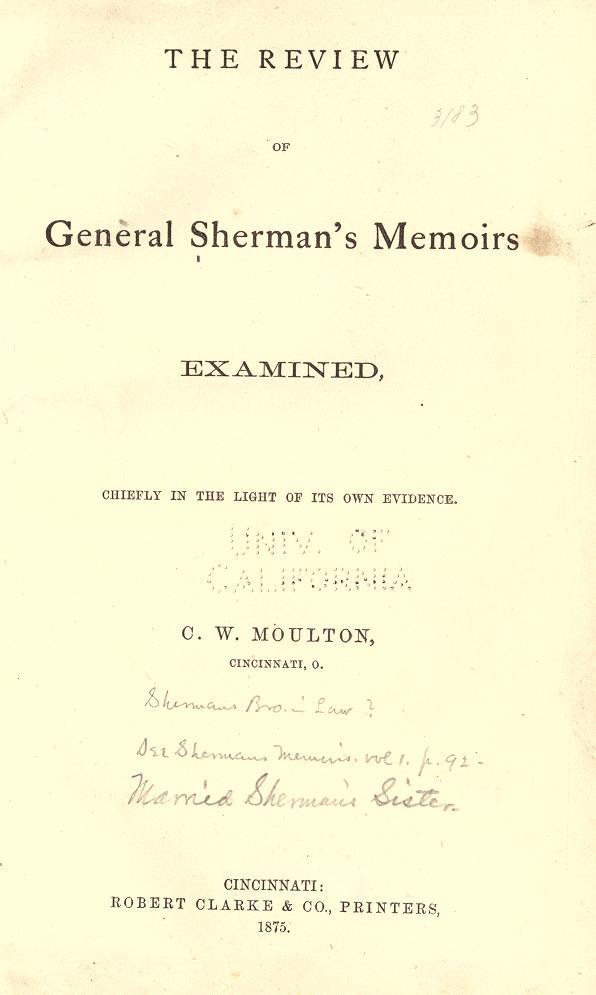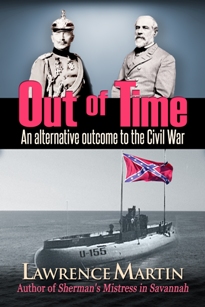
Why is Sherman's Memoirs an important book?
Sherman played a seminal role in the Civil War, and his Memoirs are considered one
of the finest writings by a modern army general. His first person account of events,
coupled with numerous letters and war department records, make his book a primary
source of information about the war.
The war ended in April 1865. Why were his Memoirs not published until 1875?
According to Wikipedia,
around 1868 Sherman began to write a "private" recollection for his children about his life before the Civil War, identified now as his unpublished "Autobiography, 1828–1861". This manuscript is held by the Ohio Historical Society. Much of the material in it would eventually be incorporated in revised form in his memoirs, which he began writing in 1872 or 1873. When he showed his work to friends they urged him to publish. The book came out as
Memoirs of General William T. Sherman. By Himself. It was published by D. Appleton & Co., in two volumes.
He began with the year 1846 (with the Mexican War) and ended with Chapter 24,
"Conclusion - Military Lessons of the War." (Cover of 1875 edition is shown below left; the two volumes standing are shown right.)


What was the reaction to the book?
Generally favorable. However, many other participants in the war began to nitpick, as it were, and wrote Sherman letters pointing out areas of disagreement or outright errors. The most forceful argument was a 276-page book published in 1875, called Sherman’s Historical Raid. The Memoirs in the light of the Record. A review based upon compilations from the files of the War Office, by Henry V. Boynton. Cincinnati: Wilstach, Baldwin & Co. 1875.

Henry Van Ness Boynton (June 22, 1835 - June 3, 1905) was a Union Army officer during the American Civil War and a recipient of the Medal of Honor for his actions at the Battle of Missionary Ridge, Tenn., November 25, 1863. In 1875 he was a reporter for the Cincinnati Gazette. Using War Office records, Boynton methodically detailed discrepancies in the Sherman book. He even went so far as to use a binding nearly identical to Sherman's (blue, with horizontal black bands, as shown below; compare with image of Sherman's Memoirs, above).

Boynton's account has been called
"an informed though hostile critique of the memoirs." Boynton wrote:
In response, Sherman enlisted his brother-in-law Charles W. Moulton to write a detailed rebuttle (published at Sherman's expense). During the war Moulton was Assistant Quartermaster of Volunteers, and in 1861 served as Captain under General McClellan in West Virginia. Moulton resigned in 1864 with rank of Colonel in the Quartermaster's department. In 1875 he was also, like Boynton, an experienced journalist. The result was an 87-page pamphlet titled
The Review of General Sherman’s Memoirs Examined, by Charles William Moulton, 1875.

In his Preface Moulton wrote:
Thus, in sequence and all published in 1875, you have 1) Sherman's Memoirs, followed by 2) Boynton's critical review, followed by 3) Moulton's counter-review upholding Sherman's account of events.
What was all the fuss about?
Essentially, Boynton was critical of Sherman's conduct of the war, of his characterization of certain generals (e.g., accusing general George Thomas of being slow to enter battle in Tennessee), and of not giving proper credit where he thought it was due. It is a point-by-point condemnation of Sherman's conduct as general, calling into question his veracity and character. Specific charges were that Sherman:
- failed to perform his duty at the battle Missionary Ridge
- failed to capture or destroy General Johnston's army at the Dalton, and unjustly censured General McPherson for its escape
- was incapacitated at the battle of Atlanta
- was careless in allowing General Hardee to escape from Savannah
- was not the originator of the famous "March to the Sea", but General Grant was
Moulton countered these criticisms one by one. Regarding the last one, Moulton wrote:
Grant was president when Sherman's book came out. Before reading it, however, he learned of Boynton's criticisms, and was quite dismayed that the journalist would call his old friend, in effect, a liar. Though quite busy with official duties, he sent for a copy of Sherman's 2 volumes and went through them line by line over a 3-week period. From his review Grant concluded:
Others came to the Sherman's defense, including
Union Cavalry General Judson Kilpatrick in a long letter to the New York Times January 24, 1876. The extant documents, in hindsight, make Boynton's book seem like a 'hatchet job', authored more for some personal aggrandizement than to set the record straight.
How did Sherman react to Boynton's criticims?
Initially Sherman arranged for several people, including his brother-in-law Moulton, to write tracts rebutting Boynton. But Boynton's diatribe continued to disturb him. In 1880 he was interviewed by a reporter for the Cleveland Leader and was quoted as stating about Boynton: "Everybody knows him to be a notorious slanderer. You could hire him to do anything for money. Why, for a thousand dollars, he would slander his own mother."
At that, Boynton began court proceedings, suing Sherman for slander and libel and requesting a court martial for
Sherman with the charge of "conduct unbecoming an officer and a gentleman." The request went all the way to Boynton's
friend, President Rutherford B. Hayes, who denied the court martial. Sherman then challenged Boynton to sue him in civil courts but no further legal action was taken. Essentially, Boynton backed down from a legal fight, and Sherman ended up winning the battle of words.
(The Chickamauga Campaign, ed. by Steven E. Woodworth, pp, 171-172)
When did the 2nd edition come out?
Sherman did acknowledge some plain factual errors brought to his attention in the 1875 publication, and many of them were corrected in a single-volume reprint of the book published in 1876. Then, over the next 10 years Sherman carefully asseembled a pile of letters received from many sources, with an eye to publishing a revised 2nd edition of the book. In 1886, just after publication of Grant's Memoirs, a fully revised 2nd edition was published by Appleton. The 2nd edition is considered the most important of the 4 editions, because it was personally revised by Sherman (unlike the 3rd and 4th editions). Changes in the second edition included:
- About 50 corrections and revisions made to the body of the text, all of them minor but in respose to letters and comments received the previous decade. Sherman refused to revise his original text on the ground that "I disclaim the character of historian, but assume to be a witness on the stand before the great tribunal of history" and "any witness who may disagree with me should publish his own version of [the] facts in the truthful narration of which he is interested."
- A new Preface, so the book has both the original and a 2nd Preface
- A new chapter at the beginning of the book, covering period 1820-1846
- A new chapter at the end of the book covering events after the war, ending with his 1884 retirement from the army.
- An appendix listing many of the letters he received.
- Portraits and improved maps.
- An index.
When did the 3rd edition come out?
Subsequently, Sherman shifted to the publishing house of Charles L. Webster & Co., the publisher of Grant’s memoirs. The new publishing house brought out a
"third edition, revised and corrected" in 1890,
Volume I and
Volume II.
This edition was substantively identical to the second (except for the omission of Sherman's short 1875 and 1886 prefaces, both quoted above).
When did the 4th edition come out?
There were TWO 4th editions. After Sherman died in 1891, his first publisher, Appleton, reissued the original (1875) edition with two new chapters about Sherman’s later years added by the journalist W. Fletcher Johnson. This is the 1891 Johnson edition: Volume I, Volume II.
Meanwhile, Charles L. Webster & Co. (Sherman's new publisher) issued a "fourth edition, revised, corrected, and complete" with the text of Sherman’s second edition, a new chapter prepared under the auspices of the Sherman family bringing the general’s life from his retirement to his death and funeral, and an appreciation by Congressman James G. Blaine (who was related to Sherman's wife). Note that this edition omits Sherman’s prefaces to the 1875 and 1886 editions (1891 Blaine edition: Volume I, Volume II).
Both the
Johnson 4th edition
and the
Blaine 4th edition
used the same galleys as the 2nd edition, so the basic text is all original Sherman; the added material is by others.
Which edition of Sherman's Memoirs is recommended?
For general purposes the
2nd edition is recommended. It includes Sherman's own revisions, and has pictures, improved maps and an index. It also has the added advantage of being easily available for a reasonable price in a modern reprint (all editions are available for downloading on the internet; see links in the left column). If you are ordering the book (as opposed to reading it free on-line), the recommended text is the 1990 publication by Library of America. This volume contains the complete 2nd edition of Sherman's Memoirs, plus a detailed chronology of Sherman's life and notes on the text by Charles Royster (b. 1944), Boyd Professor of History at Louisiana State University and author of The Destructive War: William Tecumseh Sherman, Stonewall Jackson, and the Americans.
How much are orginal editions of Sherman's Memoirs?
Original editions are widely available for sale on the internet. As with all historic books, the price varies on the basis of rarity, condition and whether or not it is signed by the author. For unsigned copies of the first or second edition, the price seems to run anywhere from about $100 to $900, the latter price for a very fine 1st edition from The Manhattan Rare Book Company.
Abebooks.com lists many copies for sale. This list includes modern editions (such as that published by Library of America), as well as original editions printed in the 19th century. Also check out
Bauman's Rare Books,
which sells original editions from time to time.
This signed copy of the 4th edition (the Blaine version) was advertised for $2400, but was marked as sold when accessed 12/30/2012. The same book without the inscription was listed for $600 at this
Bauman Rare Books web site.
Contact Lawrence Martin
First posted Jan 5, 2013; last revised September 20, 2014
 Out of Time: An Alternative Outcome to the Civil War
Out of Time: An Alternative Outcome to the Civil War